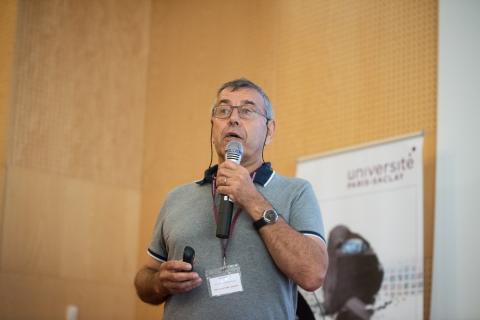
Jean-Pierre Mahy: When chemistry and biology combine to improve our daily lives
A chemist at the interface of biology, Jean-Pierre Mahy is a researcher at Orsay Institute of Molecular Chemistry and Materials (ICMMO - CNRS/Université Paris-Sud). He tirelessly promotes chemistry, which he has greatly contributed to structuring within Université Paris-Saclay.
Chemistry was revealed to Jean-Pierre Mahy in high school and his vocation as a researcher became self-evident during the 3rd year of his internship in a laboratory of the École supérieure de chimie de Paris, which he completed with Daniel Mansuy at the ENS. "I started working on liver enzymes involved in drug metabolism," he says. The young engineer was recruited by the CNRS in the same laboratory in 1984 and defended his thesis two years later. He became director of research at the CNRS in 1999 when he took over the management of the ICMMO, and a professorship at Université Paris-Sud.
On all fronts
Jean-Pierre Mahy became Director of the Doctoral School of Chemistry and then launched the CHARMMMMAT Labex (chemistry of multifunctional molecular architectures and materials) which, starting in 2012, helped to federate chemists into "a campus of chemistry south of Paris, from Cachan to Gif-sur-Yvette, long before we talked about Université Paris-Saclay," he explains. "Chemists have gained enormously. That is why I encourage my colleagues to participate in events such as Meet my Platform - Chemistry, IUPAC 2019 symposium or the Chemistry Days.
Research, teaching, administration, Jean-Pierre Mahy does "his three jobs to the core!" Currently head of the Chemistry department at Université Paris-Saclay, he also "loves" teaching his undergraduate students, which he finds rewarding. His course, "Chemistry and the Origins of Life", prepared with Rachel Méallet-Renault (Head of Chemistry Masters at Université Paris-Saclay), talks about the beginnings of life on Earth and the formation of the first molecules.
At the interface of chemistry and biology
From organic synthesis to materials, the ICMMO covers all aspects of chemistry. It is one of the largest chemical laboratories in France (320 people, including 150 permanent staff), which Jean-Pierre Mahy managed from 2006 to 2014. Its research is at the interface of organic / inorganic / biological chemistry, whose applications are in the environment (chemistry for renewable energies) and health (multicatalysis for molecule synthesis), and are based on two pillars of the CHARMMMAT Labex. The first concerns bio-inspired multicatalysis. "The idea is to chemically mimic, in the same pot, the catalytic cascades that occur in our cells," explains the researcher. His team specializes in biocatalysis processes for pollution control, the transformation of CO2 into renewable fuels or efficient catalytic processes for fine chemical synthesis. "We are working on the most eco-friendly reactions possible, using a non-polluting solvent - water being the ideal - and at a reasonable temperature". The other pillar applies to biomaterials, "such as intelligent sensors for information transmission," he says.
Artificial enzymes
Jean-Pierre Mahy's team is working to develop artificial metallo-enzymes by inserting metal complexes into various "scaffolding" that give them better stability and activity, and induce selectivity in the catalyzed reaction. The team interacts with its counterparts at Université Versailles Saint-Quentin-en-Yvelines to insert microenzymes into porous materials called MOF (metal organic framework), and with biologists at Université Paris-Sud to insert them into totally artificial proteins, called alpha-Reps. "Our chemistry binds the metal complex in the proteins produced by biologists and turns them into totally artificial metallo-enzymes," he says. The concept should extend to the development of artificial metallo-enzymes on the surface of living cells: "The idea is to use a receptor on the surface of the cell, which contains the therapeutic molecule, and to graft a metal complex onto it to catalyse reactions. The catalyst will either transform a pro-drug into a drug (this is called bi-therapy) or change the pro-probe into a probe (fluorescent). In this case, we will visualize where the therapeutic molecule is directed in the cell. It's quite powerful," concludes the researcher, who is increasingly aware of being "accountable" for improving the lives of his fellow citizens in three major societal issues: health, energy and pollution.
